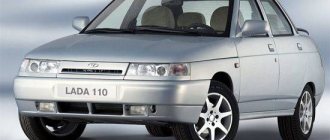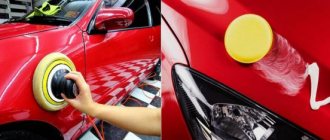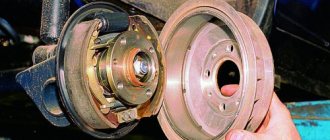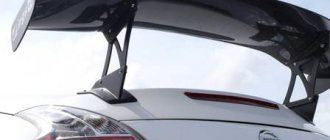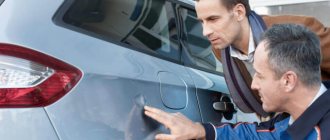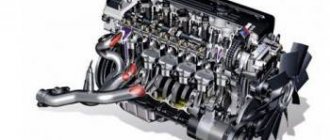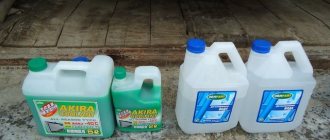Today our world does not stand still and is developing. A lot of technologies and innovations are emerging. Robots, nanotechnology. All this says only one thing - life goes faster and faster every day. In such a situation, you yourself need to keep up with all the trends of this world. And to do this, you need to transfer to your own transport. Yes, today you won’t surprise anyone with a car, but it’s a great option to always be in touch and be where you want at any time. Having your own car is definitely freedom. Although, even today, despite the huge amount of information, many people wonder how to choose a car? And this is not surprising, because it is difficult for a beginner to immediately understand all the intricacies and nuances of the purchase. It is very important to determine and understand what kind of car you need. Therefore, in this article we will talk about how to choose the right car for yourself and not make a mistake.
What questions to ask yourself before buying
Purchasing a car is a rather serious and balanced decision. It must be supported by clear desires and goals. To do this, you should ask yourself a number of questions before purchasing:
- Do you even need a car? Yes, it would seem a simple question, but sometimes there is no answer. You always need to know why you need a vehicle and how it will serve you. Will it really be cost-effective, or is it easier to do without it?
- Do you have a place to store it and park it? A car is almost a living creature and it has its own conditions for use. Ideally, this should be a garage that would hide the car from weather inconveniences. If it is not there, then just a permanent place where you will park the car will do. It is important that it is convenient and easy to get there.
- Used or new? This is also one of the important aspects, since each owner looks at this differently. Some people don’t want to overpay for a new model when it’s easier to get a slightly older, but cheaper one. And someone doesn’t want to take a car after another person. Discuss this issue and come to the desired conclusion.
- Can I support her? This question follows from the previous one and also affects which car to buy. After all, it is important to understand that a car may be cheaper and require large investments, or it may be more expensive, but then you will need to tinker with it less. Although even new cars require investments from time to time, and these expenses need to be calculated before purchase, and you also need to know whether you will be able to pay them.
- Which car and how to choose? And here we come to one of the main questions. If you have already decided for sure that you need a car, estimated your budget, calculated the pros and cons, then you only need to choose the right car based on certain parameters. To do this, you need to study a lot of materials and know at least approximately the type and variant of the car that suits your needs.
Budget
Before you start searching for the best car for yourself, you should decide on your budget. Of course, for unconditional car fans, putting money at the forefront may look somewhat blasphemous, however, as practice shows, choosing a car according to its parameters should start from this point, since this is the most important parameter when choosing a car.
The cost of a car, both new and used, consists of explicit and hidden payments. Well, firstly, this is the price of the car itself. Secondly, there are mandatory expenses for consumables. Thirdly, this is the price of repairs, the service life of the units and elements of the car.
For example, when buying a Royce-Rolls today, you pay a lot of money once for advanced solutions in the world of automotive manufacturing, and the company takes on all subsequent expenses for consumables. Other car companies cannot afford this, but they offer quite decent discounts for service in official services using official equipment.
There are not many such car companies, but they do exist. Well, the most common option is that after buying a car you will be left alone with all the problems that may arise in the car.
Realistically assessing your capabilities, you should separate a small part (8-10%) from the total budget for “finishing” the car. This money for a new car will be used for gasoline for break-in, additional devices, elements, car updates that will make the car drive the way you want it, and for priority maintenance.
For a used car, this money will go towards repair work, which may well be needed even for the most carefully selected car in fully working condition. Still, the years take their toll and you should be prepared to make certain changes to the car.
What parameters should you use to choose a car?
This is the same question that many ask themselves. There are a lot of things that can affect a person’s choice: color, appearance, and engine life. Yes, it’s not that simple, but there are several basic parameters by which you should choose your future car. Here are a few:
- Vehicle class and characteristics. You must understand what kind of car you want - more representative and presentable, or simpler, so that you can drive it without problems. Also in terms of characteristics - whether the car’s speed, acceleration, off-road qualities are important to you, would you like a more cargo-carrying or passenger model. By choosing a class, you will be closer to your goal.
- Brand. Here, everyone probably has their own preferences and leaders, so choose the brand whose cars you consider good and necessary for you.
- Engine volume. Engines are different and for different tasks. Some can swell and produce power on the highway, while others drive quietly in city mode. Some are more demanding, others are the opposite. Also, maintenance costs vary.
- Gearbox - if you like to personally change gears and feel the car, a manual is for you. If you don’t want to think and bother your head - automatic.
- Drive unit. It comes in front and back. Each of them has its own pros and cons, which everyone is free to determine for themselves.
- Safety. A very, very important parameter. Today, every modern car is somehow equipped with various security systems, but despite this, even this component has its own leaders. If this is important to you, rely on this option.
- Additional functions. Here we include things that you can drive in the car without, but are still more comfortable with them. This includes cruise control, an audio system, and air conditioning with seat heaters. All this is individual and depends on the amount and the specific car.
- Car body. Of course, this is also one of the decisive factors, since the internal spaciousness and external behavior of the car depend on the body.
Criterias of choice
Having decided why you need a car and its approximate cost, pay attention to the following important criteria:
- size;
- convenience of cargo transportation;
- transmission type;
- engine capacity;
- drive unit;
- equipment;
- options;
- brand and class;
- new or used.
Selecting a car model by size
Let's highlight 12 body types of passenger cars:
- Sedan. Two or four door. A classic five-seater car, as everyone is used to seeing it.
- Hatchback. Three or five door. This body type is as common as the sedan. Characterized by a short rear overhang. The wheelbase is shorter than that of the sedan. This type of car is more suitable for urban conditions.
- Station wagon. A sedan version, but with five doors. The trunk is spacious. The rear overhang is often longer than that of a sedan.
- Liftback. A type of hatchback. There is a step on the rear door that makes the car look like a sedan in profile. The rear overhang is like that of a sedan or station wagon.
- Coupe. Two-door cars with a short wheelbase. There are sports coupes or sports cars (Porsche 911) and executive cars (Mitsubishi 3000GT).
- SUV. A car with increased ground clearance. It has increased cross-country ability and all-wheel drive. The most prominent representative is Jeep.
- Crossover. Externally it resembles an SUV, but with lower ground clearance. A car designed to drive on good asphalt surfaces.
- Pickup. A small truck with an open trunk. Two or four door. Prominent representatives of Isuzu D-Max, Jeep Gladiator, Nissan Titan and others.
Convenience of cargo transportation
Trunk volume is important, but still not the most important component when choosing a car. When going to a car dealership, think about how important it is, how much cargo you plan to transport - minimum and maximum. Taking a bigger car just “to have it” is pointless. In addition, you will have to pay for this pleasure.
Average data on trunk volume by body type:
- Hatchback. Variations on the theme of such a body are crossovers and liftbacks. Trunk volumes by type: small - up to 250 l (Chevrolet Spark, Daewoo Matiz), medium - 250-450 l (class B and C cars), 450 l or more (Nissan Tiida, Skoda Octavia).
- Sedan. There are two options for luggage racks: medium - volume 400-500 liters (Honda Accord) and large - over 500 liters (Huyndai Solaris).
- Station wagon. Variations on the theme of such a body are SUVs and SUVs. There are also two options for luggage racks: medium - 500-600 liters (Ford Mondeo Wagon) and large - over 600 liters (Mitsubishi Outlander XL).
Transmission Automatic or manual transmission
Young people naturally choose automatic. People aged 40 and older who still have a manual transmission are wary of an automatic transmission - it’s quite difficult to get used to it out of habit. However, it should be noted that a manual transmission is still relevant, especially on Russian off-road conditions, where an automatic transmission is simply powerless.
Its advantages:
- reliability and efficiency;
- fast, almost instantaneous response;
- the ability to “rock” the car when slipping.
Switching from automatic to manual is not recommended - it will take too long to adapt.
Engine capacity
Two parameters depend on it - torque and power. And another very important thing for a car enthusiast is fuel consumption. The more spacious the engine, the more voracious it is. For driving exclusively around the city, they usually choose small cars or cars with engines up to 2 liters. If a person spends approximately 50% of his time driving on the highway, you can choose something more powerful, for example, a 3-liter engine. In any case, you will need to find out how much horsepower it produces and what its fuel consumption is, then make a decision.
Rear, front or all wheel drive
Here everything is decided individually and it is hardly worth relying on someone else’s experience. Test machines with different types of drives. This is the only way to determine for yourself what is suitable and what is not.
There are 4 types of drives in total:
- Front (FWD). Used in powerful vehicles such as pickup trucks. The downside is high cost and lack of efficiency.
- Rear (RWD). They are equipped with inexpensive cars that do not develop high speeds and are also economical in terms of fuel consumption.
- Full (4WD). You can still find cars with such a drive on sale, but they are gradually giving way to those equipped with AWD.
- AWD. Cars with such a drive, as a rule, are crossovers; torque is transmitted to the front wheels, and the rear wheels are used only when there is not enough traction. Switching occurs automatically.
Equipment
Even the most affordable cars are produced by manufacturers in different trim levels. Standard, also known as minimal, includes the smallest set of options. The truth here is that it all depends on the make of the car. In exclusive Jaguars or Jeeps, even the standard equipment is crammed to capacity with all sorts of useful gadgets. This could be climate control, cruise control, heated seats, heated mirrors, a modern multimedia system and much more.
In simple cars, such as Renault Logan or Renault Megane, a similar list is available for an additional fee. Thus, you can choose a cool car with a standard configuration or an inexpensive one, but equipped with all sorts of “tricks”, thus improving the comfort of the driver and passengers.
The price for the basic version of the car you choose should be approximately two-thirds or a little more of the entire purchase budget. Otherwise, there is a high risk of not receiving what you expected from the package.
Options
They have a direct connection with the package. Often on the websites of dealership centers the name of something is written (air conditioning, climate control, parking sensors, various airbags, light and rain sensors, active or passive cruise control) and a postscript is placed next to it - optional. This means that some configuration does not include the listed elements, but they can be installed for an additional fee.
There are two types of options - factory and from the dealership. Preference should be given to the first. This, as a rule, includes different types of engines, automatic or manual transmission, and paint color.
Car make and class
It’s useless to advise anything here. You still need to listen to other people’s opinions, at least in terms of repairs, and they are inevitable, no matter how carefully the car is handled.
Otherwise, if you read numerous motorist forums, there will be those who criticize even the most luxurious and expensive cars - Jaguars, Lexuses, Jeeps, etc. Moreover, it is not a fact that what one car enthusiast does not like will turn out to be just as inconvenient (inappropriate) for another.
In Russia you can buy cars from the auto industries of China, Japan, France, the USA, Great Britain, Italy, Germany, and Kazakhstan.
Often the decision to choose a particular brand of car becomes final after analyzing the cost of spare parts, so calculate everything in advance. For example, if we compare Citroen and Volkswagen, then replacing the hydraulic suspension with variable ground clearance in the first will cost an order of magnitude more. Same with Volvo and Ford. Replacing the muffler of the first will cost three times more than that of the second.
New or used
The age-old question: should I buy a new car or a used one, but of a higher class? It always remains open because there are many opinions on this matter. Some people think that a car should be new, even simple and the most inexpensive, but only from the assembly line and with a guarantee. Another is willing to pay twice as much for a used BMW or Jeep. In any case, the guideline is the amount a person is willing to part with when buying a car:
- New. It is believed that such a machine will operate without breakdowns for at least 3 years. And we are talking about the simplest brands, such as the Korean Datsun. Expensive luxury cars, subject to correct operation and regular maintenance, can operate without breakdowns for 5 years.
- Used up to three years. There is a high demand for executive cars in this segment. There is a certain contingent of car enthusiasts who change cars every 3 years. As a rule, such equipment is in very good condition, so if you have the money, this is a great option.
- Used after three years. A solution for people who have little money, but really want to have a car. They even got their license, but still haven’t got the wheels. The secondary market provides the opportunity to purchase such a car.
Buying a car is a complex process. It is difficult, and sometimes impossible, to figure out all the issues on your own, so the best solution is to buy a car at a car dealership. Many of them offer their customers new and used cars.
Choosing a body type
Why is this parameter so important? The fact is that it is the body type that often plays a decisive role in the behavior of the car on the road. Depending on the power, drive type and some other parameters, the body type may or may not always be successful. So choosing carefully here will help a lot and make your purchase even better.
Hatchback
This type is a slightly shortened sedan, that is, its trunk is continuous with the roof. There are two and four doors. It has a huge advantage in terms of maneuverability - hatchbacks are often small, passable even in small streets and on busy roads. They almost always look like some kind of sports car, and the design attracts them. Plus, their price is almost always cheaper, because these are cars below the executive class. They also have high ground clearance, which allows you to safely drive off the asphalt and feel confident. This is also facilitated by the suspension, which is always a little stiffer than others. Among the minuses, we note the small capacity of the trunk and the fact that the trunk itself can only be opened together with the glass. Because of this, the glass is often dirty and almost all hatchbacks have rear wipers.
Sedan
Unlike the first type of car, the sedan has a separate trunk from the passenger compartment, and is more spacious. If you need to transport cargo, then several bags or boxes will fit. The rear window doesn't move here, so it's usually always clean. The relatively spacious interior makes you feel freer. Regarding the minuses, the handling of the sedan will be worse, since its dimensions will be larger. Parking will also take up a little more space. Also, due to the low body height, it is not recommended to travel outside the city in such a car, unless of course the manufacturer has provided an off-road option. Overall, this is a typical city car for every day.
Station wagon
The third type of car body, which is one of the most common. This car has one of the best spaciousness among passenger cars, which is not surprising. This is facilitated by the increased feed and trunk. Station wagons are perfect for those who often transport some kind of cargo, go to the forest or fishing, carry a stroller or some other bulky items. It is also very roomy, you can accommodate passengers and they will not feel cramped inside. Of course, in terms of maneuverability and control, it loses to almost everyone, because driving such an often long car is not always convenient. Especially in a city where there are a lot of other cars and a lot of traffic. And there’s almost no need to talk about its off-road qualities, although such cars often have good suspension.
Minivan
This type of car is officially considered a family car, and for good reason. Here are the best characteristics of the hatchback and station wagon. From the first, minivans received a rounded body, good off-road qualities, and maneuverability. The station wagon has a lot of space and a huge trunk. Also, most often in such cars you can install an additional row of seats and transport the whole family at once, including with things. Moreover, the minivan is higher than previous bodies, and therefore the road can be seen better. At the same time, this car cannot be called particularly long, because the length is compensated by the height. Security is also higher here. But, it will not be so easy for beginners to get used to this type of car because of its heaviness. Also, fuel consumption will be higher. The possibility of rolling over is also higher here due to the center of gravity.
SUV
The name itself speaks for itself. Such cars are designed for areas where there is no road as such. They are bought by people who often travel through villages, forests, fields, rough terrain, and so on. This body is high, which allows for better control of the road. They most often have roomy trunks and interior, but some examples do not differ in this, so choose carefully. Typically, SUVs, or jeeps in other words, are classified into compact, mid-size and full-size. They also have a high center of gravity and can tip over as a result of sudden maneuvers. You will need to get used to this when driving, because SUVs are most often all-wheel drive.
Pickup
Another interesting body type, which has an open trunk at the rear and is divided into the same three types as the SUV. Most often needed by those who transport any goods or cargo. The spacious trunk is also suitable for trips out of town. Can be all-wheel drive. The dimensions are quite large, depending on the type. More popular in countries where the weather is approximately the same all year round.
Crossover
This type of car is very often confused with an SUV, as they can be similar in appearance. The whole difference is that the crossover also has something from a passenger car. Most often, this is the entire chassis, which is why they are more suitable for the city and infrequent trips out of town. If you want a city car with a brutal look, crossovers are for you.
Coupe
The most compact body type. It got its name because it has two doors and is designed for city driving. This car is suitable only for lovers of compactness and minimalism, because such a car will drive in the city without much effort. In maneuverability it has practically no equal. Its disadvantages are that the trunk plays the role of a purely conventional detail, like the rear seats, in which it is extremely difficult to carry someone. Therefore, buy a coupe after weighing the pros and cons.
Convertible and Roadster
These two body types are most often combined into one and are two or four-door cars without a roof at all, or with a folding one. They are designed to be ridden in good weather for your own pleasure. If there is a roof, then you can drive in worse weather, but the rear seats are almost the same as in the coupe, and the trunk is not particularly large. This is definitely not a car for every day, and you need to understand this.
What to choose - new or used
It seems that this is a rhetorical question. Who would prefer a used product to a new one? However, not everything is so simple. Due to the crisis, prices even for budget cars have increased significantly. What can we say about foreign cars if a domestic Lada Vesta with a rich configuration costs more than 1 million rubles? If we are talking about the premium segment, then with an amount of less than 2.5 million rubles there is nothing to do there at all. Therefore, many people opt for the used option.
Advantages of a used car:
- An opportunity to consider premium segment models on a limited budget (but you need to evaluate whether you really need a premium used car, or whether a new modern budget car with a lot of additional options will satisfy all your needs).
- Opportunity to purchase a model that is no longer in production.
- Service at any service of your choice. Use of any consumables and spare parts.
Cons of a used car:
- Wear of parts.
- Any repairs are at your expense, because there is no warranty on a used car.
- There are many pitfalls when choosing a car. For example, incorrect mileage, unregistered accidents, hidden defects.
Read on topic: Instructions: which used cars are worth buying for different budgets
Pros of a new car:
- Factory warranty. Usually this is 2, 3 or 5 years. There may be mileage restrictions (for example, 2 years or 100 thousand kilometers - whichever comes first) or no restrictions.
- No wear on parts.
Disadvantages of a new car:
- High price.
- Partial loss of value immediately after leaving the dealership.
- Dealer service is not cheap. To avoid voiding the factory warranty, a new car must be serviced only by official dealers and only use original expensive consumables.
An example of calculating the cost of scheduled maintenance (changing engine oil, oil, air and cabin filters). The car is a Hyundai Solaris II (2020), 1.6 liter engine, 123 horsepower.
| Official dealer | Third party technical center | |
| Cost of work | 4760 ₽ | 1600 ₽ |
| Original consumables | 6952 ₽ | 4000 ₽ |
| Non-original consumables | — | 3270 ₽ |
| Total | 11 712 ₽ | With original consumables: 5600 ₽ With analogues: 4870 ₽ |
Choosing a gearbox
The gearbox is one of the most important components in the car itself. Initially, car enthusiasts are divided into two types - manual enthusiasts and automatic enthusiasts. Some people want to drive the car completely, others prefer not to occupy their minds. But, automatic transmission is also divided into several types.
Mechanical
This type has long been tested by time and experience, but today it is not so often found on new cars. Despite this, let's talk about its advantages:
- Better acceleration. Experienced drivers who feel the car can guess and change gear at the right moment.
- Fuel economy. Here you can also play on changing gears on time and using neutral gear.
- Eats less oil.
- Can work even at sub-zero temperatures.
- Repairs will be cheaper and easier.
- Predictability of management and the ability to manage the process yourself.
One of the disadvantages is the inconvenience of control, especially for beginners. When moving a lot at speed, it will be difficult to shift and the dynamics will drop. Also, the revolutions here will be high, and the engine will wear out more, as will the clutch.
Automatic
The second, beloved by many, type of gearbox. Among the advantages here:
- Convenience and ease of control. The driver should not think about the clutch and gear shifting.
- Speed. Boxes that have only 4 gears will lose speed to manual ones, but an automatic with 6-8 gears will leave the competitor behind.
- Suitable for busy city traffic
- Control of engine temperature and speed, which allows you to go without repairs longer.
The disadvantages, as we have already noted, are that they do not work very well in sub-zero temperatures, maintenance is more expensive, and repairs are correspondingly more expensive.
Robotic
This type of box is somewhat similar to a mechanical one, since here the owner also controls most of the processes. The difference is perhaps that there are only two pedals, and the clutch is released automatically. It will not let you skid for a long time or just burn rubber. When stopping, you will need to engage neutral gear. Among the advantages, fuel and oil consumption is less than that of full-fledged automatic machines; the price for this type of gearbox is lower. Sometimes gear shifting is carried out using steering wheel paddles, which is also convenient.
Variable speed drive
This type is also called a continuously variable transmission. It, unlike a conventional automatic, does not switch anything but operates in a constant driving mode. The slightest movement of the car causes the gear ratios to change in one direction or another. Therefore, this option is considered very comfortable and smooth. Yes, the driver has a certain number of gears that can be changed, but most often these are just modes that also work on their own. Another huge advantage is that this version of the box is very fast and the acceleration here is probably the most effective. Of course, there are also some disadvantages here - maintenance is very expensive, because such a box can overheat, and this is critical for it. Also, the oil will need to be changed quite often, and then some components of the box itself. So here everyone decides for himself.
Tips for choosing a car for dummies
Let's start with the technical stuffing. We tell you what engines and gearboxes there are.
Engines: technical characteristics of future cars
A car is chosen not only by its appearance. You need to know what kind of gearbox it has (important for women) and engine (critical for the budget).
Table 1 . Engine types
| Engine | Fuel type | pros | Minuses |
| Atmospheric | Petrol | Easy to repair Average consumption No drop in speed | Foreigners are capricious about oil in conditions of Russian dust |
| Atmospheric turbo | Petrol | Drives more interesting than conventional engines | Used options may have a dead turbine = expensive repair or replacement |
| Diesel | Diesel (diesel) | Pulls from the very bottom | Capricious in winter, requires additives for normal operation |
| Turbodiesel | Diesel (diesel) | Dynamic overclocking | The turbine may be worn out There is a “turbo lag” - a failure during acceleration |
| On gas | Liquefied gas | Economical, cheaper than gasoline | Requires documents for installed equipment Hard to start in cold weather |
| Hybrid | ICE + electricity | Low consumption Quiet | Batteries wear out over time and lose capacity. |
| Electro | Electricity | Does not depend on gasoline | Need special charging Power reserve is short |
Read about the engines in detail at the link.
Remember, the heavier the car and the faster the acceleration, the higher the fuel consumption.
What types of gearboxes are there?
When choosing a vehicle, the following words appear in the description: automatic transmission, CVT, robot. What do they mean? Let's look at it in the table.
Table 2 . Types of gearboxes
| Gearbox type | pros | Minuses |
| Mechanical, manual transmission | Cheapest for service Towing is not prohibited | It’s hard to learn to drive with it: there is a separate pedal for the clutch in the cabin |
| Automatic, automatic transmission | Easy to learn to drive Reliable | If it breaks, prepare a lot of money for repairs or a new one. |
| Robotic, manual transmission | Like an automatic machine - easy to use | Fails due to frequent standing in traffic jams |
| CVT | The most dynamic overclocking | Like any machine, it’s expensive to maintain |
More details about the boxes here.
Which engine to choose
Another important question is which engine to choose? A lot depends on the engine: speed, power, running of your car, its gluttony. Most often, potential buyers choose between a diesel and gasoline engine.
If we are talking about a diesel engine, then it is more sensitive, but very high-torque. Most often suitable for driving long distances on the highway. It takes longer to warm up, but also has better performance at speed, as you need to change gear less often. It can also carry a large load even uphill. For this reason, it is often installed on different types of trucks. A gasoline engine is perfect for the city, because to use it to its fullest you need to switch frequently, which is quite realistic in the city. Diesel engines are more expensive, but their fuel costs less. Consumption is also slightly less. Servicing a diesel engine will be more expensive, since it has a higher load. But, when selling, they will give more for a car with a diesel engine than for the same one with a gasoline one. Plus, diesel is better for the environment because it emits less harmful substances.
Lately, gas cars have also become popular. They differ in that the gas equipment itself costs money, but gas is slightly cheaper than gasoline and diesel. Although gas will not provide the same power as gasoline. Therefore, the choice is yours.
How to choose a used car?
If you decide to buy a car second-hand, then this question is quite logical. Today, the used car market is very large, because both cars from twenty years ago and last year can be considered as such. There are a lot of options, at different prices. Of course, when buying, you need to pay attention to many aspects, because there are many people who sell outright slag under the guise of good cars. So how to choose the right used car? Here are a couple of tips:
- Year of manufacture and mileage. The car you want to buy for yourself must be age-appropriate with its mileage. Sometimes you can find old cars with low mileage. This is real, but most often the mileage is simply twisted. Also, you should not buy a new car with a very large number of kilometers on the speedometer. The year of manufacture will help you choose the best car and understand the approximate condition of the car.
- Maintenance and operation. In order to eliminate possible problems in the future, you need to find out under what conditions the machine was used, what was done to it, and what repair work was done. If the seller is hiding something, it is better to refuse.
- Cost of repairs and maintenance. It is also important to find out how much it costs to maintain such a machine, which parts are prone to breakdowns, how much it costs to repair them and how often. The easiest way is to read people's reviews on forums and various websites.
- Specifications. If you have settled on one option, then study all its characteristics, modifications, options for another engine or gearbox in order to get the full benefit from the ride. If something doesn’t suit you, then look for a car with the characteristics that you need.
- Safety is one of the key factors, because a car must meet at least minimum safety standards and its elements must be checked on site.
- Availability of services. You must be confident that you can have your car repaired at a service center without any inconvenience.
- Documents and VIN code. It is very important to always check who the seller is, what account he has, and whether the car is registered to him. Often outbid buyers do not do the registration themselves. The VIN code is a unique number of the car, by which it passes through various databases. If it’s not there, then it’s definitely not worth buying a car. Using it you can always check the condition and accidents of the car previously.
- Car condition. It is very important to check the condition of the car when purchasing. Before doing this, it is important to study all problem areas and inspect them. Trust but check. The photo does not always correspond to reality.
- Price. Based on all the parameters above, it is worth saying that the price, especially for used cars, should always be reduced. Try to bargain and try to find something to grab onto. Most often, this helps save some money for the new owner.
And a few more tips, finally:
- do not forget that the seller’s main goal is to sell his car, therefore, despite the condition, the car being sold will always be “excellent,” in his words;
– when buying, try out other cars on the go to choose the best one;
– it is necessary to inspect the suspension, brake system and engine;
– check the interior, inspect the steering wheel adjustments, the condition of the seats, the operation of the seat belts;
Have you made sure that the chosen car is of good quality? Then you can get down to paperwork and enjoy your purchase.
Expert advice
If you decide to buy a car, there are a few tips to follow, especially for beginners:
- Do not buy expensive cars on the cheapest budget - they will be in poor condition, possibly after an accident.
- Very old, obsolete cars. In the current conditions, they cannot always cope with the rhythm of driving.
- A car that has had more than 3 owners. It is often very difficult to trace history and their past.
- Cars with larger engines require more fuel consumption and more expensive maintenance.
- Choose a car that is not very large in size.
- Definitely safe. Ideally, of course, one that will have all modern systems.
- Front-wheel drive or all-wheel drive is better - this will allow less slipping in winter, and skidding will be minimal.
Of course, it all depends on experience and personal preferences, but the first car should be simple and reliable; learning to drive one will be easier and less scary.

